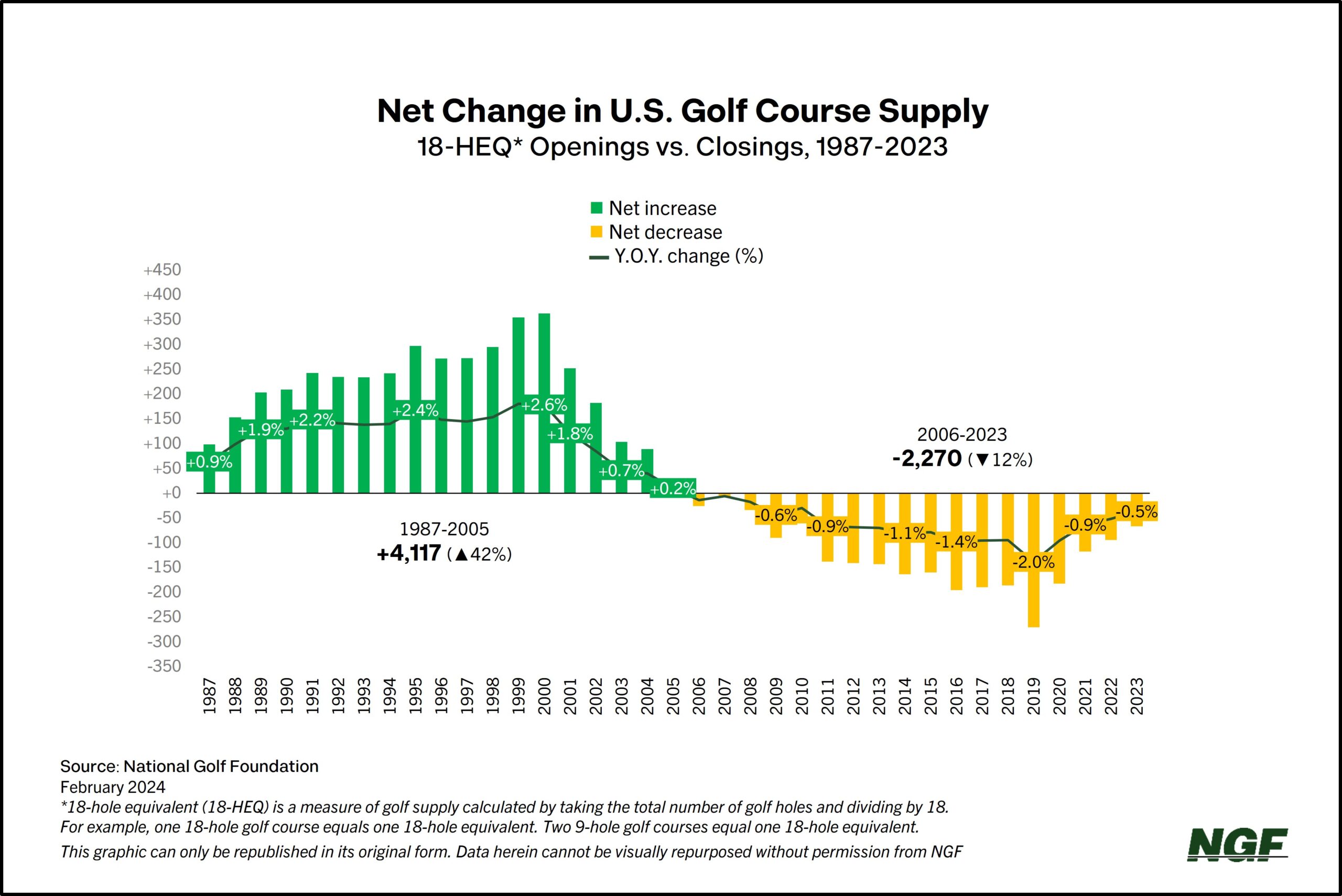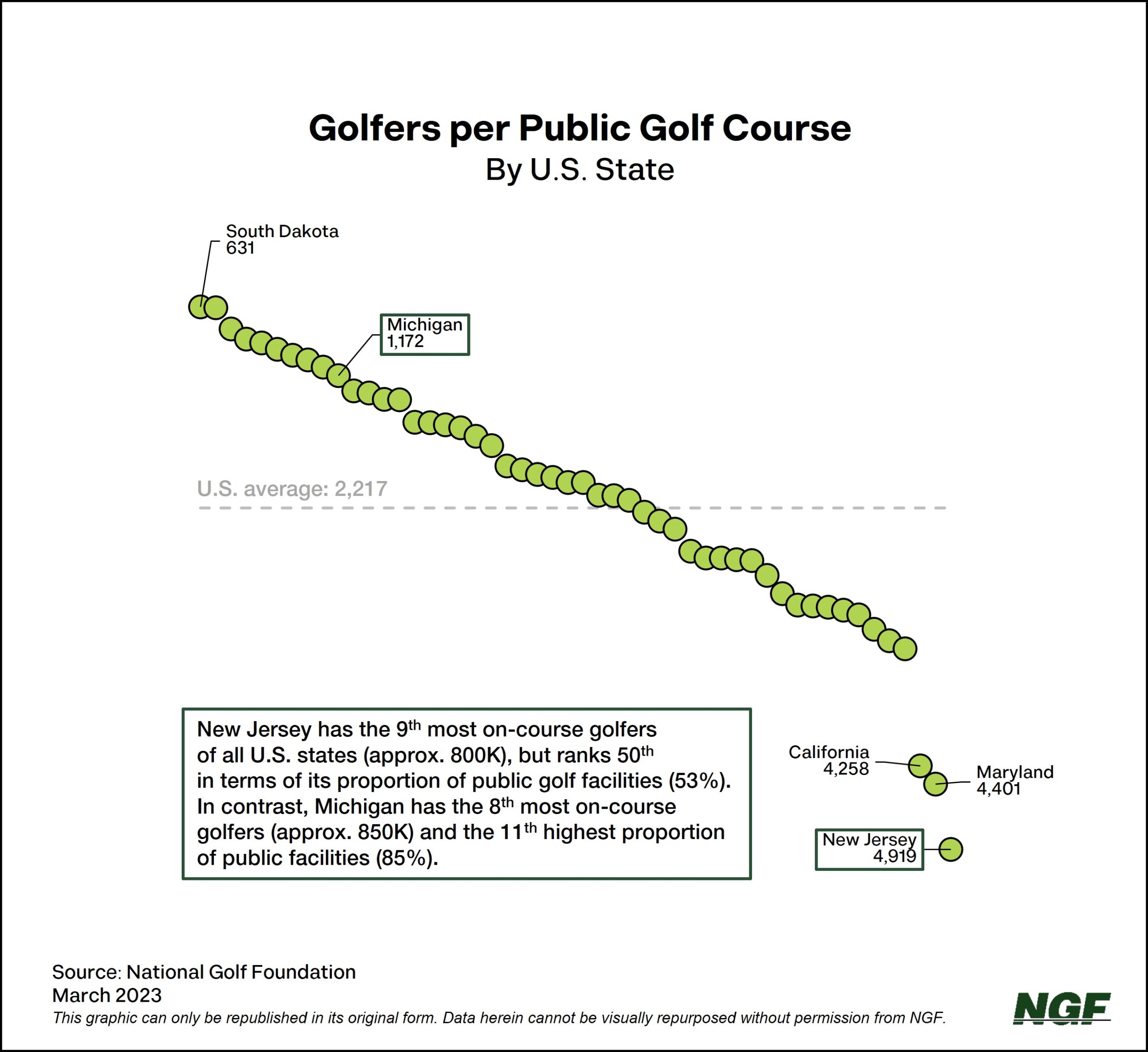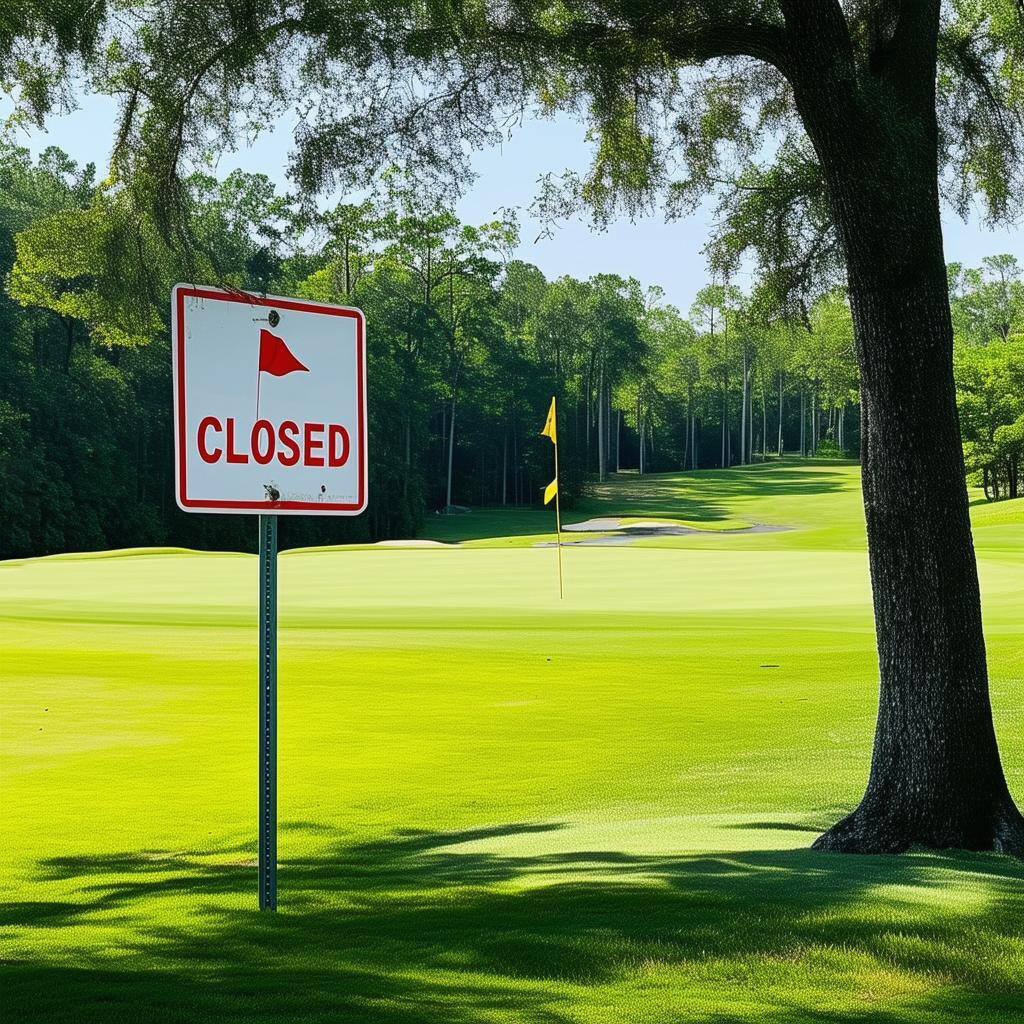When we documented the tee time struggles Southern California golfers are facing right now, part of the explanation was that there simply may not be enough courses to support all the golfers in the region. It's a simple explanation, but one that lacks a simple solution. Is there anything that can be done to support golf's recent surge in popularity, and do we need to stop it from getting worse?
Are there enough golf courses to meet demand?
For about a 20-year period, starting in the 1980s and culminating when Tiger took the golf world by storm, golf saw an unprecedented growth in popularity. Seeking to capitalize on this newfound demand, golf courses were popping up literally every day (over 400 courses a year opened during the 90s) and the supply of golf courses increased by 44%. The trend didn't last forever, though, with the recession in 2008 rapidly transitioning golf from a growth industry to one in decline.
This pattern seemed to be the new normal for golf, which meant that many of these newly-constructed facilities no longer saw enough traffic to justify operating costs. Courses began closing up shop nearly as quickly as they had opened in the previous era, peaking with nearly 300 course closures nationwide in 2019. Then the pandemic hit, people began seeking outdoor recreation outlets, and golf's popularity was rejuvenated.
The number of golfers has risen steadily each year since 2020. Even more significant is the jump in the number of rounds played each year by golfers, which has seen record numbers since 2022. But perhaps learning from the downfall of the previous boom, the golf course supply hasn't seen the drastic uptick that would seemingly follow increased play. The number of courses closing has significantly subsided, but the number of courses opening also hasn't matched those that shuttered during golf's downswing. This means there are 2,000 less golf courses than during golf's previous peak two decades ago, which leads to one thing -- courses are busier than ever.

National Golf Foundation
According to data from the National Golf Foundation, 59% of public courses and 71% of private courses are at or near capacity, defined as the most amount of golf a facility can handle before it has a negative impact on business. After all, there can only be so many players on the course at one time before complaints arise about pace of play and customers start heading to other courses or activities. As the data shows, the impact is being felt across every facility, regardless of price point. When new golfers started impacting the available tee times at public courses, many golfers decided to finally take the leap and join a private club. This increase in golfers flocking to private clubs has, in turn, caused these clubs to start turning away prospective members in order to maintain a positive experience for the current membership. Across the nation, there simply aren't enough courses to satisfy the demand.
Where does Southern California stand on golf supply?
As seems to generally be the case, California is in a particularly unique position when it comes to this issue. It should come as no surprise that California is among the leaders in available golf courses, with its count of 961 trailing only Florida. But unlike some of the other golf-rich states in the country, our state also has to deal with the demand of 2.8 million golfers trying to access these courses, by far the most in the country. Factor in that only a bit over two-thirds of the courses in the state are open to the public and you end up with over 4,200 golfers per public facility, nearly double the national average. And that's before you also account for the golfers flocking from out of state for our world-class courses and year-round golf season.

National Golf Foundation
The pressure in Southern California is being felt across golf facilities of every type. Even with the abundance of private clubs available in the state, most of them have reached capacity and simply can't take on new members. Meanwhile public courses are trying to balance packing the tee sheet as much as possible while still maintaining a reasonable pace of play. Municipal courses carry the additional weight of doing this while keeping prices affordable to make the course accessible to anyone, which opened the door for brokers to seize the opportunity and capitalize on a market willing to pay higher prices for prime tee times. Despite all that, the number of rounds played in Southern California continues to increase: Los Angeles, Orange, and San Diego Counties have increased play by over 5% since last year.
While the simple answer may appear to be "build more golf courses", that's not a straightforward proposition in California. Land and water are at a premium here and those two resources are the most critical in constructing a golf course. You might counter with the fact that there is plenty of unoccupied land outside of the major urban areas, but then again, most of that land isn't exactly suitable to raise a golf course and even if you did, you'd have to find a way to get people to travel out there to play it. Compounding the issue is that of the courses that are already operating, several face the threat of being repurposed for other uses.
Saving Southern California Golf Courses
Although the rapid post-recession course contraction has been largely halted because of golf's resurgence, course closures unfortunately haven't (and never will) reach zero. In a region where course expansion is near impossible, this means that each potential shutdown is felt even harder and could impact thousands of golfers. That's not to mention that a disproportionate number of these closures are in the "value" course category, which serve a crucial part in introducing beginner and junior golfers to the sport and preserving the health of the game. So when local governments aim to repurpose golf land or bills like the Public Golf Endangerment Act are introduced, it sets off alarm bells across the Southern California golf community.
Thankfully, it isn't all bad news these days. Because of the work being done by groups like the SCGA, local golf committees and advocacy groups, and passionate golfers making their voices heard with their representatives, some of these threats have been quelled. Here are some of the areas where golf has been rescued recently:
Sepulveda Basin

OLIN
When the City of Los Angeles released their initial draft of the Sepulveda Basin Vision Plan, it included options to remove up to 27 holes between Encino GC, Balboa GC, and Woodley Lakes GC. However, it was made evident to the planners that losing that many holes at courses that host upwards of 250,000 rounds of golf each year would be a significant detriment to the community. The final plan, released in June, includes all 54 holes of golf with plans to restructure areas most impacted by flooding and reuse some of the surrounding land as natural habitat.
Ventura
Photo: Anthony Plascencia/VC Star
Buenaventura GC found itself under water-quite literally-when torrential rainstorms in 2023 flooded the course. When the initial restoration plans discovered that preventing this event from occurring again in the future weren't feasible, some advocated for the closure of the course. However, thanks to some tireless work from members of the local golf clubs with support from the SCGA, the Ventura City Council voted unanimously to award a contract to develop a scope of work that considers the hydraulics of the adjacent river, identifies potential flood mitigation measures, protects the integrity of the golf property, evaluates different course structures/routings/holes, vets potential new revenue streams – all in an updated golf course design consistent with the footprint available after application of whatever additional mitigation measures are revealed by the study. The effort also led to the resurrection of Ventura's Citizen Golf Advisory Group.
Two years after flooding threatened its future, Buenaventura GC was able to reopen 14 of its holes in May 2025 and opened all 18 holes in August 2025.
Palm Springs

The Tahquitz Creek neighborhood in Palm Springs is home to a popular 36-hole track that became the target of a land trust looking to acquire the property from the city. The community was distraught over the news but lacked the organization to prevent the sale; that is, until Ernest Ceceña stepped in and launched the "Save PS Golf" campaign. Ceceña, who isn't even a golfer himself but saw how much the course meant to his neighbors, was able to rally enough support for Tahquitz Creek GC that the land trust ultimately set its sights elsewhere.
How Can You Help?
These success stories of heroic efforts offer a hope of a bright future for golf, but the unfortunate reality is that these battles will always be ongoing. Despite these clear examples that golf holds significant value in communities across the region, there will always be a debate as to the most efficient use of land that only becomes more valuable with each passing year. So what should you do if you some day find your favorite course on the chopping block?
Speak Up
These issues rarely come and go without spending some time in the public forum. Write to your representatives, show up to a city council meeting, reach out to the course management; let anyone who has a say in the matter know that golf matters to the community.
Find a Golf Advocacy Group
If you want to find an avenue to dive deeper than just whether a course lives or dies, seek out if your city or region has some form of golf advisory or advocacy committee. These groups help direct local governments on planning, budgeting, and regulatory issues surrounding municipal golf courses and help maintain the health of municipal courses, which can prevent these discussions from arising in the first place.
Join the SCGA
Not everybody has the time to dedicate to saving golf courses across the state. Thankfully, the SCGA does. You may just think of the SCGA as a place to get your Handicap Index or play in a golf tournament, but we also have a dedicated Public Affairs team that advocates on behalf of golf to local committees, Sacramento, and everywhere in between.
Get your SCGA membership today and your membership can help protect the future of golf in Southern California.


